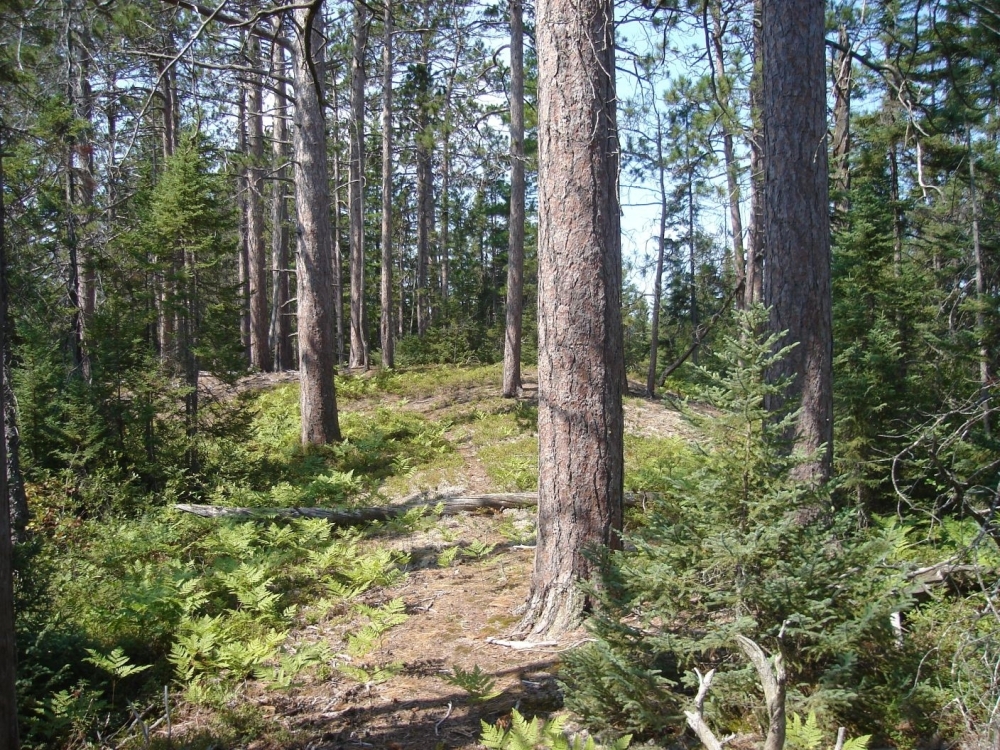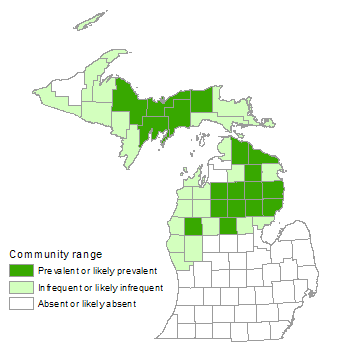Dry Northern Forest
Overview
Dry northern forest is a pine- or pine-hardwood-dominated forest type that occurs on dry sandy sites lying mostly north of the climatic tension zone. Two distinct variants are included within this community type, one dominated by jack pine (Pinus banksiana) or jack pine and hardwoods, and the other dominated by red pine (P. resinosa). Prior to European settlement, dry northern forest typically originated in the wake of catastrophic fire. Frequent, low-intensity ground fires maintained red pine systems by removing competing hardwoods.
Rank
Global Rank: G3? - Vulnerable (inexact)
State Rank: S3 - Vulnerable

Landscape Context
Dry northern forest occurs principally on sandy glacial outwash and sandy glacial lakeplains, and also commonly on sand ridges within peatlands on glacial outwash or glacial lakeplains.
Soils
Soils are coarse-textured, well-sorted, excessively drained dry sands with low amounts of organic matter and low water-holding capacity. The droughty soils are extremely acid to very strongly acid with low nutrient content and high frost proclivity.
Natural Processes
The natural disturbance regime of dry northern forest is characterized by infrequent catastrophic fire, with estimated return intervals ranging from 10 to 80 years in jack pine forests and 120 to 300 years in red pine forests. Red pine-dominated forests also experienced frequent, low-intensity, stand-perpetuating surface fires, with estimated return intervals ranging from 5 to 20 years. Windthrow, insect epidemics, and growing-season frosts are also important disturbance factors.
Vegetation
The overstory of dry northern forest is dominated by jack pine (Pinus banksiana) or red pine (P. resinosa). Northern pin oak (Quercus ellipsoidalis) usually accompanies jack pine in the canopy; big-toothed aspen (Populus grandidentata), red maple (Acer rubrum), and paper birch (Betula papyrifera) are typical canopy associates in stands of red pine. Red pine, white pine (P. strobus), and balsam fir (Abies balsamea) often occur in the subcanopy. Low sweet blueberry (Vaccinium angustifolium), bush honeysuckle (Diervilla lonicera), and sweetfern (Comptonia peregrina) are typically prevalent in the shrub layer. The ground layer is dominated by Pennsylvania sedge (Carex pensylvanica) and bracken fern (Pteridium aquilinum). Other typical species include serviceberry (Amelanchier spicata), spreading dogbane (Apocynum androsaemifolium), bearberry (Arctostaphylos uva-ursi), hair grass (Avenella flexuosa), pipsissewa (Chimaphila umbellata), poverty grass (Danthonia spicata), trailing arbutus (Epigaea repens), wintergreen (Gaultheria procumbens), huckleberry (Gaylussacia baccata), rattlesnake weed (Hieracium venosum), cow-wheat (Melampyrum lineare), rice grass (Piptatherum pungens), sand cherry (Prunus pumila), northern dewberry (Rubus flagellaris), starflower (Trientalis borealis), and velvetleaf blueberry (Vaccinium myrtilloides). Important bryophytes include lichens (Cladina rangifera and C. mitis) and mosses (Dicranum spp., Hypnum spp., and Pleurozium schreberi).
For information about plant species, visit the Michigan Flora website.
Plant Lists
Graminoids
- wavy hair grass (Avenella flexuosa)
- long-awned wood grass (Brachyelytrum aristosum)
- sedges (Carex foenea, C. pensylvanica, C. siccata, and others)
- poverty grass (Danthonia spicata)
- rough-leaved rice grass (Oryzopsis asperifolia)
- rice grass (Piptatherum pungens)
Forbs
- spreading dogbane (Apocynum androsaemifolium)
- wild sarsaparilla (Aralia nudicaulis)
- bluebell (Campanula rotundifolia)
- fireweed (Chamerion angustifolium)
- pink lady-slipper (Cypripedium acaule)
- large-leaved aster (Eurybia macrophylla)
- rattlesnake weed (Hieracium venosum)
- twinflower (Linnaea borealis)
- Canada mayflower (Maianthemum canadense)
- cow-wheat (Melampyrum lineare)
- partridge berry (Mitchella repens)
- hairy goldenrod (Solidago hispida)
- starflower (Trientalis borealis)
Ferns
- bracken fern (Pteridium aquilinum)
Lichens
- reindeer lichens (Cladina mitis and C. rangiferina)
Mosses
- fork mosses (Dicranum spp.)
- Hypnum mosses (Hypnum spp.)
- big red stem moss (Pleurozium schreberi)
Shrubs
- running serviceberry (Amelanchier spicata)
- bearberry (Arctostaphylos uva-ursi)
- pipsissewa (Chimaphila umbellata)
- sweetfern (Comptonia peregrina)
- bunchberry (Cornus canadensis)
- bush honeysuckle (Diervilla lonicera)
- trailing arbutus (Epigaea repens)
- wintergreen (Gaultheria procumbens)
- huckleberry (Gaylussacia baccata)
- sand cherry (Prunus pumila)
- northern dewberry (Rubus flagellaris)
- prairie willow (Salix humilis)
- low sweet blueberry (Vaccinium angustifolium)
- Canada blueberry (Vaccinium myrtilloides)
Trees
- balsam fir (Abies balsamea)
- red maple (Acer rubrum)
- paper birch (Betula papyrifera)
- white spruce (Picea glauca)
- black spruce (Picea mariana)
- jack pine (Pinus banksiana)
- red pine (Pinus resinosa)
- white pine (Pinus strobus)
- big-toothed aspen (Populus grandidentata)
- trembling aspen (Populus tremuloides)
- black cherry (Prunus serotina)
- northern pin oak (Quercus ellipsoidalis)
Noteworthy Animals
Kirtland’s warbler depends on large blocks of young jack pine for nesting and breeding.
Rare Plants
- Antennaria parvifolia (pussy-toes, state special concern)
- Agoseris glauca (pale agoseris, state threatened)
- Cirsium hillii (Hill’s thistle, state special concern)
- Festuca scabrella (rough fescue, state threatened)
- Oryzopsis canadensis (Canada rice-grass, state threatened)
- Prunus alleghaniensis var. davisii (Alleghany plum, state special concern)
- Pterospora andromedea (pine-drops, state threatened)
Rare Animals
- Accipiter gentilis (northern goshawk, state special concern)
- Appalachia arcane (secretive locust, state special concern)
- Atrytonopsis hianna (dusted skipper, state threatened)
- Dendroica discolor (prairie warbler, state endangered)
- Dendroica kirtlandii (Kirtland’s warbler, federal/state endangered)
- Falco columbarius (merlin, state threatened)
- Haliaeetus leucocephalus (bald eagle, state threatened)
- Incisalia henrici (Henry’s elfin, state special concern)
- Incisalia irus (frosted elfin, state threatened)
- Merolonche dolli (Doll’s merolonche, state special concern)
- Pandion haliaetus (osprey, state threatened)
- Picoides arcticus (black-backed woodpecker, state special concern)
- Pyrgus wyandot (grizzled skipper, state special concern)
Biodiversity Management Considerations
Fire suppression can result in failure of pine to regenerate, invasion by shade-tolerant species, and eventual conversion of dry northern forest to more mesic forest types. Naturally regenerated, mature red pine-dominated forest is a rare forest type in the Great Lakes region. In fire-suppressed landscapes, natural red pine stands can be maintained by prescribed surface fires.
Numerous invasive plants are common in the ground layer of openings within dry northern forests, especially where fire has been excluded. Prevalent non-native plants include spotted knapweed (Centaurea stoebe), common St. John’s-wort (Hypericum perforatum), hawkweeds (Hieracium spp.), sheep sorrel (Rumex acetosella), Canada bluegrass (Poa compressa), Kentucky bluegrass (P. pratensis), timothy (Phleum pratense), and common mullein (Verbascum thapsus). Efforts to monitor and control invasive species are critical for protecting biodiversity.
Logging and slash fires likely resulted in an increase in acreage of mature dry northern forest dominated by jack pine and a decrease in red pine-dominated systems. Fire suppression has resulted in conversion of dry northern forest to more mesic forest types and also the conversion of pine barrens to dry northern forest. Many sites formerly occupied by natural pine forest were planted to pines in the 1920s and 1930s and these have been maintained as plantations. Bracken-grassland is likely derived from disturbed dry and dry-mesic northern forests. Natural openings in dry northern forest exist in small depressions (i.e., frost pockets) due to microclimatic effects (primarily cold air drainage), but logging and slash fires produced the extensive “stump prairies” dominated by lichens, poverty grass, bracken fern, and invasive plants, which typically include bluegrasses, hawkweeds, sheep sorrel, timothy, and common mullein. Very slow invasion of these sites by choke cherry (Prunus virginiana), black cherry (Prunus serotina), quaking aspen (Populus tremuloides), and paper birch (Betula papyrifera) is taking place.
Variation
Major vegetative variants include jack pine forest, jack pine-hardwood forest, and red pine forest. Jack pine or mixed jack pine forest occurs on expanses of dry sandy outwash plains, especially in the northern Lower Peninsula, and tend to be broad and extensive in area. Red pine-dominated systems occur on inland dune ridges and also on high elevation ice-contact island ridges within jack pine- or jack pine-red pine-dominated outwash plains and tend to be narrow and linear in shape, like the landforms they occupy. Jack pine-northern pin oak forest typically occurs adjacent to pine barrens.
Similar Natural Communities
Pine barrens, dry-mesic northern forest, oak-pine barrens, and wooded dune and swale complex.
Places to Visit
- Barclay Lake Jack Pines, Newberry State Forest Management Unit, Luce Co.
- Clark Lake Pine Ridges, Tahquamenon Falls State Park, Chippewa Co. and Luce Co.
- Crawford Red Pines, Grayling Forest Management Unit, Crawford Co.
- Hartwick Pines, Hartwick Pines State Park, Crawford Co.
- Prison Camp Dry Northern Forest, Tahquamenon Falls State Park and Newberry State Forest Management Unit, Luce Co. and Chippewa Co.
- Roscommon Red Pines, Roscommon Forest Management Unit, Roscommon Co.
Relevant Literature
- Cayford, J.H. 1970. The role of fire in the ecology and silviculture of jack pine. Proceedings of the Annual Tall Timbers Fire Ecology Conference 10: 221-244.
- Cohen, J.G. 2002. Natural community abstract for dry northern forest. Michigan Natural Features Inventory, Lansing, MI. 14 pp.
- Heinselman, M.L. 1973. Fire in the virgin forests of the Boundary Waters Canoe Area, Minnesota. Journal of Quaternary Research 3: 329-382.
- Simard, A.J., and R.W. Blank. 1982. Fire history of a Michigan jack pine forest. Michigan Academician 15: 59-71.
- Stocks, B.J. 1989. Fire behavior in mature jack pine. Canadian Journal of Forest Research 19: 783-790.
- Van Wagner, C.E. 1970. Fire and red pine. Proceedings of the Annual Tall Timbers Fire Ecology Conference 10: 211-219.
- Whitney, G.C. 1986. Relation of Michigan’s presettlement pine forest to substrate and disturbance history. Ecology 67(6): 1548-1559.
For a full list of references used to create this description, please refer to the natural community abstract for Dry Northern Forest.
More Information
Citation
Cohen, J.G., M.A. Kost, B.S. Slaughter, D.A. Albert, J.M. Lincoln, A.P. Kortenhoven, C.M. Wilton, H.D. Enander, and K.M. Korroch. 2020. Michigan Natural Community Classification [web application]. Michigan Natural Features Inventory, Michigan State University Extension, Lansing, Michigan. Available https://mnfi.anr.msu.edu/communities/classification. (Accessed: January 10, 2026).
Kost, M.A., D.A. Albert, J.G. Cohen, B.S. Slaughter, R.K. Schillo, C.R. Weber, and K.A. Chapman. 2007. Natural Communities of Michigan: Classification and Description. Michigan Natural Features Inventory, Report No. 2007-21, Lansing, MI.


